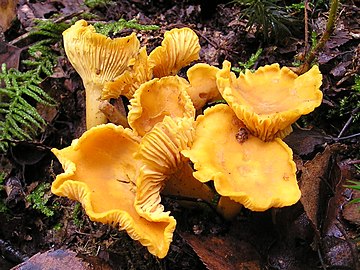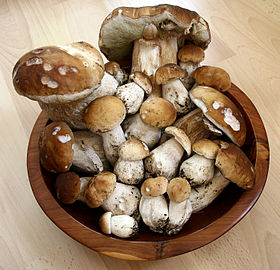Edible mushroom
This article needs additional citations for verification. (November 2018) |

Edible mushrooms are the fleshy fruit bodies of numerous species of macrofungi (fungi that bear fruiting structures large enough to be seen with the naked eye). Edibility may be defined by criteria including the absence of poisonous effects on humans and desirable taste and aroma. Mushrooms that have a particularly desirable taste are described as "choice". Edible mushrooms are consumed for their nutritional and culinary value. Mushrooms, especially dried shiitake, are sources of umami flavor.
To ensure safety, wild mushrooms must be correctly identified before their edibility can be assumed. Deadly poisonous mushrooms that are frequently confused with edible mushrooms include several species of the genus Amanita, particularly A. phalloides, the death cap. Some mushrooms that are edible for most people can cause allergic reactions in others; old or improperly stored specimens can go rancid and cause food poisoning.[1] Additionally, mushrooms can absorb chemicals within polluted locations, accumulating pollutants and heavy metals including arsenic and iron—sometimes in lethal concentrations.
Several varieties of fungi contain psychedelic compounds—the magic mushrooms—while variously resembling non-psychoactive species. The most commonly consumed for recreational use are Amanita muscaria (the fly agaric) and Psilocybe cubensis, with the former containing alkaloids such as muscimol and the latter predominately psilocybin.
Edible mushrooms include many fungal species that are either harvested wild or cultivated. Easily cultivated and common wild mushrooms are often available in markets; those that are more difficult to obtain (such as the prized truffle, matsutake, and morel) may be collected on a smaller scale and are sometimes available at farmers' markets or other local grocers. Despite long-term use in folk medicine, there is no scientific evidence that consuming "medicinal mushrooms" cures or lowers the risk of human diseases.
Description
[edit]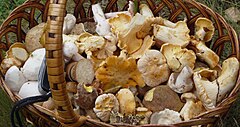
Mushrooms can appear either below ground (hypogeous) or above ground (epigeous) and can be picked by hand.[2] Edibility may be defined by criteria including the absence of poisonous effects on humans and desirable taste and aroma.[3] Edible mushrooms are consumed for their nutritional and culinary value. Mushrooms, especially dried shiitake, are sources of umami flavor.[4][5]
List of edible mushrooms
[edit]Commercially cultivated
[edit]- Agaricus bisporus dominates the edible mushroom market in North America and Europe, in several forms. It is an edible basidiomycete mushroom native to grasslands in Europe and North America. As it ages, this mushroom turns from small, white and smooth to large and light brown. In its youngest form, it is known as the 'common mushroom', 'button mushroom', 'cultivated mushroom', and 'champignon mushroom'. Its semi-mature form is known variously as 'cremini', 'baby-bella', 'Swiss brown' mushroom, 'Roman brown' mushroom, 'Italian brown' mushroom, or 'chestnut' mushroom Its fully mature form is known as 'portobello’.[6][7][8][9]
- Pleurotus species, the oyster mushrooms, are commonly grown at industrial scale.[9]
- Morchella species, (morel family) morels belong to the ascomycete grouping of fungi. Morels are difficult to grow commercially, but there are ongoing efforts to make cultivating morels at scale a reality.[10] Since 2014, some farmers in China have been cultivating morels outdoors in the spring; however, yields are variable.[10] Morels must be cooked before eating.
- Lentinula edodes, the Shiitake mushroom[9]
- Auricularia heimuer, wood ear mushroom
- Volvariella volvacea, the paddy straw mushroom or straw mushroom
- Volvariella bombycina, the silky rosegill mushroom
- Flammulina filiformis, the enoki mushroom, golden needle mushroom, seafood mushroom, lily mushroom, or winter mushroom
- Flammulina velutipes
- Tremella fuciformis, the snow fungus, snow ear, silver ear fungus and white jelly mushroom
- Hypsizygus tessellatus, aka Hypsizygus marmoreus, the beech mushroom, also known in its white and brown varieties as Bunapi-shimeji and Buna-shimeji, respectively
- Stropharia rugosoannulata, the wine cap mushroom, burgundy mushroom, garden giant mushroom or king stropharia
- Cyclocybe aegerita, the pioppino, velvet pioppini, poplar or black poplar mushroom
- Hericium erinaceus, the lion's mane, monkey head, bearded tooth, satyr's beard, bearded hedgehog, or pom pom mushroom.
- Phallus indusiatus, the bamboo mushrooms, bamboo pith, long net stinkhorn, crinoline stinkhorn or veiled lady mushroom.
Commercially harvested wild fungi
[edit]
- Boletus edulis or edible Boletus, native to Europe, known in Italian as fungo porcino (plural porcini) (pig mushroom), in German as Steinpilz (stone mushroom), in Russian as Белый гриб, Bely grib (white mushroom), in French as the cèpe, and in the UK as the penny bun. It is also known as the king bolete, and is renowned for its delicious flavor. It is sought after worldwide, and can be found in a variety of culinary dishes.
- Boletus griseus, the gray bolete
- Boletus variipes
- Boletus pinophilus, the pinewood king bolete
- Calbovista subsculpta, commonly known as the sculptured giant puffball is a common puffball of the Rocky Mountains and Pacific Coast ranges of western North America. The puffball is more or less round with a diameter of up to 15 cm (6 in), white becoming brownish in age, and covered with shallow pyramid-shaped plates or scales. It fruits singly or in groups along roads and in open woods at high elevations, from summer to autumn. It is considered a choice edible species while its interior flesh (the gleba) is still firm and white. As the puffball matures, its insides become dark brown and powdery from mature spores.
- Calvatia gigantea, the giant puffball. Giant puffballs are considered a choice edible species and are commonly found in meadows, fields, and deciduous forests usually in late summer and autumn. It is found in temperate areas throughout the world.[11] They can reach diameters up to 150 cm (60 in) and weights of 20 kg (45 lb). The inside of mature giant puffballs is greenish brown, whereas the interior of immature puffballs is white. The large white mushrooms are edible when young.[12][13]
- Cantharellus cibarius (the chanterelle). The yellow chanterelle is one of the best and most easily recognizable mushrooms and can be found in Asia, Europe, North America and Australia. There are poisonous mushrooms that resemble it, though these can be confidently distinguished if one is familiar with the chanterelle's identifying features.
- Craterellus tubaeformis, the tube chanterelle, yellow foot chanterelle or yellow-leg
- Clitocybe nuda, blewit (or blewitt)
- Cortinarius caperatus, the Gypsy mushroom
- Craterellus cornucopioides, Trompette de la mort (trumpet of death) or horn of plenty
- Grifola frondosa, known in Japan as maitake (also "hen of the woods" or "sheep's head"), a large, hearty mushroom commonly found on or near stumps and bases of oak trees, and believed to have Macrolepiota procera properties.
- Hericium erinaceus, a tooth fungus; also called "lion's mane mushroom"
- Hydnum repandum, sweet tooth fungus, hedgehog mushroom or hedgehog fungus, urchin of the woods
- Lactarius deliciosus, saffron milk cap, consumed around the world and prized in Russia
- Morchella genus (morel family) morels belong to the ascomycete grouping of fungi. They are usually found in open scrub, woodland or open ground in late spring. When collecting this fungus, care must be taken to distinguish it from the poisonous false morels, including Gyromitra esculenta. The morel must be cooked before eating.
- Morchella conica var. deliciosa
- Morchella esculenta var. rotunda
- Morchella crassipes
- Morchella elata[14]
- Pleurotus species are sometimes commercially harvested despite the ease of cultivation.
- Pleurotus ostreatus
- Termitomyces species are symbiotes of termites and the mushrooms grow out of termite mounds. This genus includes the largest edible mushroom, Termitomyces titanicus, with a cap that averages 1 m in diameter,[15] though most species are much smaller. Research is underway to determine how to cultivate these mushrooms.[16]
- Tricholoma matsutake, the matsutake, a mushroom highly prized in Japanese cuisine.
- Tuber genus (truffles). Truffles have long eluded the modern techniques of domestication known as trufficulture. Although the field of trufficulture has greatly expanded since its inception in 1808, several species still remain uncultivated. Domesticated truffles include:
- Tuber aestivum, black summer truffle
- Tuber borchii, bianchetto truffle
- Tuber brumale, muscat truffle
- Tuber indicum, Chinese black truffle
- Tuber macrosporum, smooth black truffle
- Tuber mesentericum, the Bagnoli truffle[17]
-
Chanterelles in the wild
-
Common white mushrooms cooking (raw at lower left)
-
Baskets of mixed culinary mushrooms at the San Francisco Ferry Building
-
Calvatia gigantea, the giant puffball at a market in England
-
Boletus edulis at various ages
-
Black Périgord truffle, cut in half
Other edible wild species
[edit]- Agaricus arvensis (horse mushroom)
- Agaricus silvaticus (pinewood mushroom)
- Agaricus campestris (field mushroom)
- Aleuria aurantia (orange peel fungus)
- Amanita caesarea (Caesar's mushroom)
- Armillaria mellea (honey mushroom)
- Boletus badius (bay bolete)
- Calocybe gambosa (St George's mushroom)
- Calvatia utriformis (syn. Lycoperdon caelatum)
- Calvatia cyathiformis (purple-spored puffball)
- Chroogomphus genus (pine-spikes or spike-caps)
- Clavariaceae genus (coral fungus family)
- Clavulinaceae genus (coral fungus family)
- Coprinus comatus, the shaggy mane, shaggy inkcap or lawyer's wig. Must be cooked as soon as possible after harvesting or the caps will first turn dark and unappetizing, then deliquesce and turn to ink. Not found in markets for this reason.
- Corn smut (Ustilago maydis), economically important pathogens of cereals. Known in Mexico as huitlacoche, where it is considered a delicacy. Corn smuts can be used as fillings in quesadillas, tacos and soups.[18]
- Cyttaria espinosae
- Fistulina hepatica (beefsteak polypore or ox tongue)
- Flammulina velutipes (velvet shank or winter fungus)
- Gomphidius glutinosus (slimy spike-cap)
- Hygrophorus chrysodon (gold flecked woodwax)
- Kalaharituber pfeilii

Auricularia auricula-judae - Lactarius deterrimus (orange milkcap)
- Lactarius salmonicolor
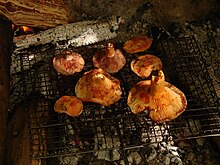
Lactarius salmonicolor - Lactarius subdulcis (mild milkcap)
- Lactarius volemus (fishy milkcap), also known as weeping milkcap
- Laetiporus sulphureus (sulphur shelf), also known by names such as "chicken mushroom", "chicken fungus"; a distinct bracket fungus popular among mushroom hunters
- Leccinum aurantiacum (red-capped scaber stalk)
- Leccinum scabrum (birch bolete)
- Leccinum versipelle (orange birch bolete / Boletus testaceoscaber)
- Macrolepiota procera (parasol mushroom); globally, it is widespread in temperate regions
- Marasmius oreades (fairy ring champignon)
- Polyporus mylittae (blackfellow's bread)
- Polyporus squamosus (dryad's saddle and pheasant's back mushroom)
- Pseudohydnum gelatinosum (toothed jelly fungus)
- Ramariaceae genus (coral fungus family)
- Rhizopogon luteolus
- Russula; some members of this genus, such as R. laeta, are edible
- Sparassis crispa, also known as "cauliflower mushroom"
- Suillus bovinus (bovine bolete)
- Suillus granulatus (weeping bolete), also known as "granulated bolete"
- Suillus grevillei (tamarack jack)
- Suillus luteus (slippery jack)
- Suillus tomentosus (woolly-capped suillus)
- Suillus brevipes (short-stemmed slippery Jack)
- Suillus pictus (painted suillus)
- Suillus decipiens
- Tricholoma portentosum
Conditionally edible species
[edit]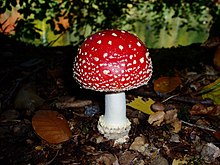
- Amanita fulva (tawny grisette) must be cooked before eating.
- Amanita muscaria is edible if parboiled to leach out toxins;[19] fresh mushrooms cause vomiting, twitching, drowsiness, and hallucinations due to the presence of muscimol. Although present in A. muscaria, ibotenic acid is not in high enough concentration to produce any physical or psychological effects unless massive amounts are ingested.
- Amanita rubescens (the blusher) must be cooked before eating.
- Coprinopsis atramentaria (Coprinus atramentarius, common inkcap) is edible without special preparation, but consumption with alcohol is toxic due to the presence of coprine. Some other Coprinus spp. share this property.
- Gyromitra esculenta (false morel, turban, brain mushroom) is eaten by some after it has been parboiled, but many mycologists do not recommend it. Raw Gyromitra are toxic due to the presence of gyromitrin, and it is not known whether all of the toxin can be removed by parboiling.
- Lactarius spp. Apart from Lactarius deliciosus (saffron milkcap), which is universally considered edible, other Lactarius spp. that are considered toxic elsewhere in the world are eaten in some Eastern European countries and Russia after pickling or parboiling.[20]
- Lactarius indigo
- Lactarius paradoxus
- Lactarius corrugis
- Lactarius volemus
- Lactarius hygrophoroides
- Lepista saeva (field blewit, blue leg, or Tricholoma personatum) must be cooked before eating.
- Morchella esculenta (morel) must be cooked before eating.[21]
- Verpa bohemica is considered choice by some—it even can be found for sale as a "morel"—but cases of toxicity have been reported. Verpas appear to contain monomethylhydrazine[22] and similar precautions apply to them as Gyromitra species.
- Tricholoma terreum (grey knight), might cause rhabdomyolysis
Cultivation
[edit]Mushroom cultivation has a long history, with over twenty species commercially cultivated. Mushrooms are cultivated in at least 60 countries.[23] A fraction of the many fungi consumed by humans are currently cultivated and sold commercially. Commercial cultivation is important ecologically, as there have been concerns of the depletion of larger fungi such as chanterelles in Europe, possibly because the group has grown popular, yet remains a challenge to cultivate.
Some mushrooms, particularly mycorrhizal species, have not yet been successfully cultivated.
In 2019, world production of commercial mushrooms and recorded truffle collection reported to the Food and Agriculture Organization was 11.9 million tonnes, led by China with 75% of the total:
| Country | Quantity (millions of tonnes) |
|---|---|
| 8.94 | |
| 0.47 | |
| 0.38 | |
| 0.36 | |
| 0.30 | |
| World | 11.90 |
| Source: FAOSTAT of the United Nations[24] | |
Safety concerns
[edit]Some wild species are toxic, or at least indigestible, when raw.[25] Failure to identify poisonous mushrooms and confusing them with edible ones has resulted in death.[25][26][27] Although in the 21st century primitive digital applications exist to aid with identification, these are unreliable and some inexperienced hunters relying upon them have been seriously poisoned.[28]
Deadly poisonous mushrooms that are frequently confused with edible mushrooms and responsible for many fatal poisonings include several species of the genus Amanita, particularly Amanita phalloides, the death cap. Some mushrooms that are edible for most people can cause allergic reactions in some individuals with no prior knowledge of an allergy; old or improperly stored specimens can go rancid quickly and cause food poisoning. Great care should therefore be taken when eating any fungus for the first time, and only small quantities should be consumed in case of individual allergies or reactions. Even normally edible species of mushrooms may be dangerous, as certain mushrooms growing in polluted locations can act as chemical-absorbers, accumulating pollutants and heavy metals, including arsenic and iron, sometimes in lethal concentrations.[29] On the other hand, some cooking preparations may reduce the toxicity of slightly poisonous mushrooms enough to be consumed as survival food, for example, many prized fungi will cause gastric upset when eaten uncooked, such as the Morchella genus.
Additionally, several varieties of fungi are known and documented to contain psychedelic drugs—the so-called magic mushrooms—yet resemble perfectly edible, non-psychoactive species. While not necessarily lethal to consume, to the uninitiated, an accidentally induced psychedelic experience can run the gamut from benign to terrifying, even depressing or psychotic. The most commonly consumed for recreational psychoactive use are Amanita muscaria (the fly agaric) and Psilocybe cubensis, with the former containing alkaloids such as muscimol and the latter predominately psilocybin. Both have the potential to induce in the user feelings of awe, wonder with nature, interesting visual hallucinations and inner peace (even in mild doses), but excessive or accidental consumption can create feelings of insanity, helplessness and fear, usually persisting for a few hours.
Nutrition
[edit]| Nutritional value per 100 g (3.5 oz) | |||||||||||||||||||||||||||||||||||||||||||||||||||||||
|---|---|---|---|---|---|---|---|---|---|---|---|---|---|---|---|---|---|---|---|---|---|---|---|---|---|---|---|---|---|---|---|---|---|---|---|---|---|---|---|---|---|---|---|---|---|---|---|---|---|---|---|---|---|---|---|
| Energy | 117 kJ (28 kcal) | ||||||||||||||||||||||||||||||||||||||||||||||||||||||
5.3 g | |||||||||||||||||||||||||||||||||||||||||||||||||||||||
0.5 g | |||||||||||||||||||||||||||||||||||||||||||||||||||||||
2.2 g | |||||||||||||||||||||||||||||||||||||||||||||||||||||||
| |||||||||||||||||||||||||||||||||||||||||||||||||||||||
| Other constituents | Quantity | ||||||||||||||||||||||||||||||||||||||||||||||||||||||
| Water | 91.1 g | ||||||||||||||||||||||||||||||||||||||||||||||||||||||
| †Percentages estimated using US recommendations for adults,[30] except for potassium, which is estimated based on expert recommendation from the National Academies.[31] | |||||||||||||||||||||||||||||||||||||||||||||||||||||||
Higher mushroom consumption has been associated with lower risk of breast cancer.[32] As of 2021[update], mushroom consumption has not been shown to conclusively affect risk factors for cardiovascular diseases.[33]
A commonly eaten mushroom is the white mushroom (Agaricus bisporus). In a 100-gram (3+1⁄2-ounce) reference serving, Agaricus mushrooms provide 92 kilojoules (22 kilocalories) of food energy and are 92% water, 3% carbohydrates, 3% protein, and 0.3% fat. They contain high levels of riboflavin, niacin, and pantothenic acid, with moderate content of phosphorus (see table). Otherwise, raw white mushrooms generally have low amounts of essential nutrients. Although cooking by boiling lowers mushroom water content only 1%, the contents per 100 grams for several nutrients increase appreciably, especially for dietary minerals.[citation needed]
The content of vitamin D is absent or low unless mushrooms are exposed to sunlight or purposely treated with artificial ultraviolet light, even after harvesting and processed into dry powder.[34][35]
Vitamin D
[edit]| Name | Chemical composition | Structure |
|---|---|---|
| Vitamin D1 | ergocalciferol with lumisterol, 1:1[36] | |
| Vitamin D2 | ergocalciferol (made from ergosterol) | 
|
| Vitamin D3 | cholecalciferol (made from 7-Dehydrocholesterol in the skin). | 
|
When exposed to UV light before or after harvest, mushrooms convert their large concentrations of ergosterol into vitamin D2.[34][35] This is similar to the reaction in humans, where vitamin D3 is synthesized after exposure to sunlight.
Testing showed an hour of UV light exposure before harvesting made a serving of mushrooms contain twice the FDA's daily recommendation of vitamin D. With 5 minutes of artificial UV light exposure after harvesting, a serving of mushrooms contained four times as much.[34] Analysis also demonstrated that natural sunlight produced vitamin D2.[35]
The form of vitamin D found in UV-irradiated mushrooms is ergocalciferol, or vitamin D2. This is not the same as cholecalciferol, called vitamin D3, which is produced by UV-irradiation of human or animal skin, fur, and feathers. Although vitamin D2 has vitamin-D activity in humans, and is widely used in food fortification and nutritional supplements, vitamin D3 is more commonly used in dairy and cereal products.
Uses
[edit]Edible mushrooms include many fungal species that are either harvested wild or cultivated. Easily cultivated and common wild mushrooms are often available in markets; those that are more difficult to obtain (such as the prized truffle, matsutake, and morel) may be collected on a smaller scale by private gatherers, and are sometimes available at farmers' markets or other local grocers. Mushrooms can be purchased fresh when in season, and many species are also sold dried.
Before assuming that any wild mushroom is edible, it should be correctly identified. Accurate determination of and proper identification of a species is the only safe way to ensure edibility, and the only safeguard against possible poisoning. Some edible species cannot be identified without the use of advanced techniques such as chemistry or microscopy.
History
[edit]Mycophagy (/maɪˈkɒfədʒi/), the act of consuming mushrooms, dates back to ancient times. Edible mushroom species have been found in association with 13,000-year-old archaeological sites in Chile. Ötzi, the mummy of a man who lived between 3400 and 3100 BCE in Europe, was found with two types of mushroom. The Chinese value mushrooms for their supposed medicinal properties as well as for food. Ancient Romans and Greeks, particularly the upper classes, used mushrooms for culinary purposes. Food tasters were employed by Roman emperors to ensure that mushrooms were safe to eat.[37] The Forme of Cury, a 14th-century compilation of medieval English recipes, features a recipe of mushrooms and leeks cooked in broth.[38]
Culinary
[edit]Cooking
[edit]
Mushrooms may be cooked before consumption to improve texture and lower trace levels of toxic hydrazines. Frying, roasting, baking, and microwaving are all used to prepare mushrooms. Cooking lowers the amount of water present in the food. Mushrooms do not go mushy with long term cooking because the chitin that gives most of the structure to a mushroom does not break down until 380 °C (716 °F) which is not reached in any normal cooking.[39][40]
Storage
[edit]
Mushrooms will usually last a few days, longer if refrigerated. Mushrooms can be frozen, but are best cooked first. They can also be dried or pickled.
In traditional medicine
[edit]Medicinal mushrooms are mushrooms or extracts from mushrooms that are thought to be treatments for diseases, yet remain unconfirmed in mainstream science and medicine, and so are not approved as drugs or medical treatments.[41] Such use of mushrooms therefore falls into the domain of traditional medicine[42] for which there is no direct high-quality clinical evidence of efficacy.[43][44]
Preliminary research on mushroom extracts has been conducted to determine if anti-disease properties exist, such as for polysaccharide-K[45] or lentinan.[46] Some extracts have widespread use in Japan, Korea and China, as potential adjuvants for radiation treatments and chemotherapy.[47][48]
-
Chicken of the woods (Laetiporus sulphureus)
-
Common morel (Morchella esculenta)
See also
[edit]References
[edit]- ^ McKnight, Karl B.; Rohrer, Joseph R.; McKnight Ward, Kirsten; MacKnight, Kent H.; MacKnight, Vera B. (2021). Peterson field guide to mushrooms of North America. Peterson field guides (2nd ed.). Boston: Houghton Mifflin Harcourt. pp. 32–35. ISBN 978-0-544-23611-0.
- ^ Chang, Shu-Ting; Phillip G. Miles (1989). Mushrooms: cultivation, nutritional value, medicinal effect, and Environmental Impact. CRC Press. pp. 4–6. ISBN 978-0-8493-1043-0.
- ^ Mattila P, Suonpää K, Piironen V (2000). "Functional properties of edible mushrooms". Nutrition. 16 (7–8): 694–6. doi:10.1016/S0899-9007(00)00341-5. PMID 10906601.
- ^ Ole G. Mouritsen; Klavs Styrbaek (2014). Umami: Unlocking the Secrets of the Fifth Taste. Columbia University Press. pp. 11, 52, 110. ISBN 978-0-231-16890-8.
- ^ Paul Adams (24 November 2015). "Put the science of umami to work for you". Popular Science, Bonnier Corporation. Retrieved 11 December 2015.
- ^ "Every Type Of Mushroom You Need To Know About". Huffingtonpost.com. 19 March 2014. Retrieved 23 October 2018.
- ^ "Common Types of Mushrooms". Realsimple.com. Archived from the original on 16 November 2018. Retrieved 23 October 2018.
- ^ "What's the Difference Between Cremini and Portobello Mushrooms?". Thekitchen.com. Retrieved 23 October 2018.
- ^ a b c "Cultivation of Oyster Mushrooms". Extension.psu.edu. Retrieved 23 October 2018.
- ^ a b Alla Katsnelson (April 26, 2022). "Cultivating Coveted Morels Year-Round and Indoors". The New York Times. Retrieved June 9, 2023.
- ^ "Calvatia gigantea (giant puffball)". Kew Gardens. Retrieved 8 August 2015.
- ^ Arora, David (1986). Mushrooms Demystified. Berkeley, California: Ten Speed Press. pp. 158–159. ISBN 978-0-89815-169-5.
- ^ Bessette, Alan E. (1997). Mushrooms of Northeastern North America. Syracuse, New York: Syracuse University Press. pp. 453–454. ISBN 978-0-8156-0388-7.
- ^ Weber, Nancy S.; Smith, Alexander H.; Guravich, Dan (1985). A field guide to southern mushrooms. Ann Arbor, Michigan: University of Michigan Press. ISBN 0-472-85615-4. OCLC 10207909.
- ^ Pegler, D. N.; Piearce, G. D. (1980). "The Edible Mushrooms of Zambia". Kew Bulletin. 35 (3): 475. Bibcode:1980KewBu..35..475P. doi:10.2307/4110017. JSTOR 4110017.
- ^ "Termitomyces: exploring the world's most mysterious mushroom". World Agroforestry. Retrieved 2022-08-18.
- ^ T. mesenterium was first reported in Great Britain after the wet August 2008: "New fungi species unearthed in UK". BBC News. 9 October 2008. Retrieved 9 October 2008.
- ^ Neimark, Jill (24 August 2015). "Scourge No More: Chefs Invite Corn Fungus To The Plate". NPR. Retrieved 2020-05-18.
- ^ Rubel W, Arora D (2008). "A study of cultural bias in field guide determinations of mushroom edibility using the iconic mushroom, Amanita muscaria, as an example" (PDF). Economic Botany. 62 (3): 223–243. doi:10.1007/s12231-008-9040-9. S2CID 19585416. Archived from the original (PDF) on 2012-04-15.
- ^ Arora, David (1986). Mushrooms Demystified, 2nd ed. Ten Speed Press.
- ^ Nordic Council of Ministers (2012). "Section 1: Nordic Risk Assessments and Background on Edible Mushrooms, Suitable for Commercial Marketing and Background Lists. For Industry, Trade and Food Inspection. Background Information and Guidance Lists on Mushrooms". Mushrooms Traded As Food. Vol. 2. Denmark: Nordic Council of Ministers. p. 50. ISBN 978-92-893-2383-3.
- ^ FDA Import Alert IA2502 Archived April 9, 2007, at the Wayback Machine
- ^ John Fereira. "U.S. Mushroom Industry". Usda.mannlib.cornell.edu. Retrieved 2010-05-30.
- ^ "Production of mushrooms and truffles in 2019, Crops/Regions/World list/Production Quantity (pick lists)". UN Food and Agriculture Organization, Corporate Statistical Database (FAOSTAT). 2020. Retrieved 3 March 2021.
- ^ a b "Wild Mushroom Warning. Mushroom Poisoning: Don't Invite "The Death Angel" to Dinner". US National Capital Poison Center, Washington, DC. 2017. Retrieved 11 January 2017.
- ^ Barbee G, Berry-Cabán C, Barry J, Borys D, Ward J, Salyer S (2009). "Analysis of mushroom exposures in Texas requiring hospitalization, 2005–2006". Journal of Medical Toxicology. 5 (2): 59–62. doi:10.1007/BF03161087. PMC 3550325. PMID 19415588.
- ^ Osborne, Tegan (2016-02-03). "Deadly death cap mushrooms found in Canberra's inner-south as season begins early". ABC News. Retrieved 2 May 2016.
- ^ Lapienytė, Jurgita (March 25, 2024). "AI tools can lead to severe mushroom poisoning". Cybernews. Retrieved 2024-03-31.
- ^ Kalač, Pavel; Svoboda, Lubomír (15 May 2000). "A review of trace element concentrations in edible mushrooms". Food Chemistry. 69 (3): 273–281. doi:10.1016/S0308-8146(99)00264-2.
- ^ United States Food and Drug Administration (2024). "Daily Value on the Nutrition and Supplement Facts Labels". FDA. Archived from the original on 2024-03-27. Retrieved 2024-03-28.
- ^ National Academies of Sciences, Engineering, and Medicine; Health and Medicine Division; Food and Nutrition Board; Committee to Review the Dietary Reference Intakes for Sodium and Potassium (2019). "Chapter 4: Potassium: Dietary Reference Intakes for Adequacy". In Oria, Maria; Harrison, Meghan; Stallings, Virginia A. (eds.). Dietary Reference Intakes for Sodium and Potassium. The National Academies Collection: Reports funded by National Institutes of Health. Washington, DC: National Academies Press (US). pp. 120–121. doi:10.17226/25353. ISBN 978-0-309-48834-1. PMID 30844154. Retrieved 2024-12-05.
- ^ Ba DM, Ssentongo P, Beelman RB, Muscat J, Gao X, Richie JP (2020). "Mushroom Consumption Is Associated with Low Risk of Cancer: A Systematic Review and Meta-Analysis of Observation Studies". Current Developments in Nutrition. 4 (2): 307. doi:10.1093/cdn/nzaa044_006. PMC 7258270.
- ^ Krittanawong C, Isath A, Hahn J, Wang Z, Fogg SE, Bandyopadhyay D, Jneid H, Virani SS, Tang WH (2021). "Mushroom Consumption and Cardiovascular Health: A Systematic Review". American Journal of Medicine. 134 (5): 637–642. doi:10.1016/j.amjmed.2020.10.035. PMID 33309597. S2CID 229179866.
- ^ a b c Bowerman, S (March 31, 2008). "If mushrooms see the light". Los Angeles Times.
- ^ a b c Koyyalamudi SR, Jeong SC, Song CH, Cho KY, Pang G (April 2009). "Vitamin D2 formation and bioavailability from Agaricus bisporus button mushrooms treated with ultraviolet irradiation". Journal of Agricultural and Food Chemistry. 57 (8): 3351–3355. doi:10.1021/jf803908q. PMID 19281276.
- ^ Kalaras MD, Beelman RB, Holick MF, Elias RJ (2012). "Generation of potentially bioactive ergosterol-derived products following pulsed ultraviolet light exposure of mushrooms (Agaricus bisporus)". Food Chemistry. 135 (2): 396–401. doi:10.1016/j.foodchem.2012.04.132. PMID 22868105.
- ^ Jordan P. (2006). Field Guide to Edible Mushrooms of Britain and Europe. New Holland Publishers. p. 10. ISBN 978-1-84537-419-8.
- ^ "The Forme of Cury". Project Gutenberg. Retrieved 17 March 2024.
- ^ Deguchi, Shigeru; Tsujii, Kaoru; Horikoshi, Koki (2015-07-07). "In situ microscopic observation of chitin and fungal cells with chitinous cell walls in hydrothermal conditions". Scientific Reports. 5 (1): 11907. Bibcode:2015NatSR...511907D. doi:10.1038/srep11907. ISSN 2045-2322. PMC 4493705. PMID 26148792.
- ^ "Why you can't really overcook mushrooms". www.pbs.org. 2022-07-20. Retrieved 2024-01-26.
- ^ Sullivan R, Smith JE, Rowan NJ (2006). "Medicinal mushrooms and cancer therapy: translating a traditional practice into Western medicine". Perspect Biol Med. 49 (2): 159–70. doi:10.1353/pbm.2006.0034. PMID 16702701. S2CID 29723996.
- ^ Hobbs CJ. (1995). Medicinal Mushrooms: An Exploration of Tradition, Healing & Culture. Portland, Oregon: Culinary Arts Ltd. p. 20. ISBN 978-1-884360-01-5.
- ^ "Reishi mushroom". MedlinePlus, US National Library of Medicine. 19 January 2019. Retrieved 24 January 2019.
- ^ Money, Nicholas P. (2016). "Are mushrooms medicinal?". Fungal Biology. 120 (4): 449–453. Bibcode:2016FunB..120..449M. doi:10.1016/j.funbio.2016.01.006. ISSN 1878-6146. PMID 27020147.
- ^ "Coriolus versicolor". About Herbs, Botanicals & Other Products. Memorial Sloan-Kettering Cancer Center. 3 October 2018. Retrieved 24 January 2019.
- ^ "Lentinan (Shiitake)". Memorial Sloan Kettering Cancer Center, New York. 2017. Retrieved 11 January 2017.
- ^ Sullivan, Richard; Smith, John E.; Rowan, Neil J. (2006). "Medicinal Mushrooms and Cancer Therapy: translating a traditional practice into Western medicine". Perspectives in Biology and Medicine. 49 (2): 159–70. doi:10.1353/pbm.2006.0034. PMID 16702701. S2CID 29723996.
- ^ Borchers, A. T.; Krishnamurthy, A.; Keen, C. L.; Meyers, F. J.; Gershwin, M. E. (2008). "The Immunobiology of Mushrooms". Experimental Biology and Medicine. 233 (3): 259–76. CiteSeerX 10.1.1.546.3528. doi:10.3181/0708-MR-227. PMID 18296732. S2CID 5643894.
External links
[edit]- . . 1914.
- "Pacific Northwest Seasonal Chart for Edible Mushrooms". Central Oregon Mushroom Club.

